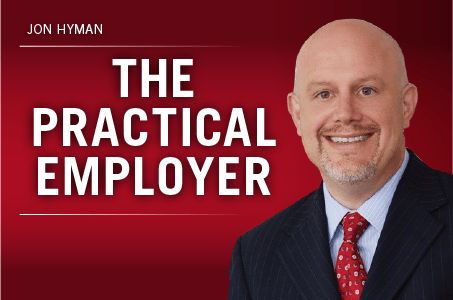News broke in early 2018 that Walmart was facing a potential class-action lawsuit in New York for allegations of pregnancy discrimination.
This lawsuit is one of several nationwide that claim that some of the nation’s largest businesses are systematically punishing pregnant employees with discriminatory policies.
Employers are facing increased exposure and liability for pregnancy discrimination in the workplace claims. The number of pregnancy discrimination claims filed annually with the Equal Employment Opportunity Commission has been steadily rising for two decades and is hovering near an all-time high. In 2017, more than 3,174 cases of pregnancy discrimination were filed with the EEOC.
The federal Pregnancy Discrimination Act is an amendment to Title VII of the Civil Rights Act of 1964, and it makes discrimination based on pregnancy, childbirth or related medical conditions unlawful. The act covers employers with 15 or more employees, including state and local governments. Women who are pregnant or affected by related conditions must be treated in the same manner as other applicants or employees with similar abilities or limitations. The law’s protections include:
Hiring and working conditions: An employer cannot refuse to hire a woman because of pregnancy, pregnancy-related conditions, or based on the prejudices of co-workers or customers. The act prohibits discrimination when it comes to working conditions, including pay, job assignments, promotions, layoffs, training, firing and any other condition of employment.
Pregnancy and maternity leave: An employer may not single out pregnancy-related conditions for special procedures to determine an employee’s ability to work. For example, if an employer does not require its employees to submit a doctor’s statement concerning their inability to work before granting leave or paying sick benefits, the employer may not require employees affected by pregnancy to provide this documentation.
Pregnancy and temporary disability: An employee that is temporarily unable to perform her job due to pregnancy must be treated the same as any other temporarily disabled employee.
Health insurance: Any health insurance provided by an employer must cover expenses for pregnancy-related conditions on the same basis as costs for other medical conditions. Pregnancy-related expenses should be reimbursed exactly as those incurred for other medical conditions.
Fringe benefits: Benefits must be the same for pregnancy as other medical conditions. If an employer provides any benefits to workers on leave, the employer must provide the same benefits for those on leave for pregnancy-related conditions, including accrual and crediting of seniority, vacation calculation, pay increases and temporary disability benefits.
Further, it is unlawful to retaliate against an individual for opposing employment practices that discriminate based on pregnancy or for filing a discrimination charge, testifying or participating in any way in an investigation, proceeding or litigation under Title VII.
Although pregnancy itself is not considered a disability, some pregnant workers may be eligible for additional protection under the amended Americans with Disabilities Act Amendments Act due to conditions related to pregnancy. The ADAAA applies to employers with 15 or more workers.
Affordable Care Act
Under the Affordable Care Act, employers must provide two things to employees for one year after a child’s birth: (1) a reasonable amount of time to express milk each time that she needs to express milk; and (2) a location to express breast milk (not a bathroom) that is shielded from view and free from intrusion from co-workers and the public.
Employers are not required to compensate nursing mothers during breaks to express milk, but if an employee has compensated breaks and she uses them to express milk, then she must be compensated in a similar way.
The ACA provides an “undue hardship” exemption for certain employers that employ fewer than 50 employees. An undue hardship will be found if the requirement imposes on the small employer significant difficulty or expense when considered in relation to the size, financial resources, nature, or structure of the employer’s business.
Importantly, the ACA provides a “floor” not a “ceiling” for regulation in this area. States remain free to adopt laws that provide additional protections beyond those provided in the ACA.
Best Practices
In some instances, employers may claim that excluding pregnant or fertile women from certain jobs is lawful due to a bona fide occupational qualification defense, or BFOQ. This defense, however, is extremely narrow and the employer must show that pregnancy actually interferes with an employee’s ability to perform the job based on objective, verifiable skills required by the job.
Employers have rarely been able to establish a pregnancy-based BFOQ. Liability under the federal and state laws can be avoided with the following best practices:
• Effectively train managers on applicable laws, workplace policies, and how to respond to requests for assistance and accommodation.
• When complaints occur, respond promptly.
• Implement strong policies against pregnancy discrimination and harassment.
• Evaluate leave policies to ensure restrictive provisions or practices do not discriminate on the basis of pregnancy or related medical conditions.
• Evaluate any workplace accommodation policies and ensure they are available to workers with pregnancy-related impairments.
• Never require — explicitly or constructively — a pregnant employee to take leave, light duty or other work accommodations that she does not want or did not request.
• Make sure policies and facilities comply with breastfeeding requirements under the ACA.
• Check state and local laws for additional requirements.
Jay Starkman is the CEO of Engage PEO, a professional employer organization providing HR outsourcing to small and mid-sized businesses across the United States. Camille Cooper is the assistant general counsel and HR consultant for Engage PEO.





 These days, particularly in the United States, it feels like the divided nature of our politics makes it almost impossible to keep from choosing sides.
These days, particularly in the United States, it feels like the divided nature of our politics makes it almost impossible to keep from choosing sides. The first group you have to carefully consider when mulling a public political stand is your employees. And here’s the first big question to ask yourself: Is your stand consistent with your stated and lived corporate values, or do those values just represent those of the CEO or some portion of the C-suite? If your stand is consistent with your stated and lived corporate values, and they’re not just the personal musings of a company executive, then you’ve got a check in the go-forward box.
The first group you have to carefully consider when mulling a public political stand is your employees. And here’s the first big question to ask yourself: Is your stand consistent with your stated and lived corporate values, or do those values just represent those of the CEO or some portion of the C-suite? If your stand is consistent with your stated and lived corporate values, and they’re not just the personal musings of a company executive, then you’ve got a check in the go-forward box.



 I’m on planes a lot for business. Recently, on a full Southwest flight, I ended up in the middle seat of an exit row next to a very large man who was seated by the window. He was cordial, but visibly uncomfortable. His long legs extended into the empty space in front of him where a seat would have been had he occupied any other row. He politely tried to retract his substantial arms enough to allow my petite frame to have some room on the arm rest. I thought about what it must be like for him to have to cram his generous body into a “regular” seat, among unfamiliar faces, smiling uncomfortably next to a tiny porthole of a window, for three hours. I wondered how he’d gotten this particular seat — one of only two on the plane he fit into. Did he pay extra for business select priority seating? Did he wait by his computer to check in exactly 24 hours before his flight to win a low boarding position? Did he just hope an exit row seat would be available, or rely on the generosity of an earlier stranger to willingly give one up?
I’m on planes a lot for business. Recently, on a full Southwest flight, I ended up in the middle seat of an exit row next to a very large man who was seated by the window. He was cordial, but visibly uncomfortable. His long legs extended into the empty space in front of him where a seat would have been had he occupied any other row. He politely tried to retract his substantial arms enough to allow my petite frame to have some room on the arm rest. I thought about what it must be like for him to have to cram his generous body into a “regular” seat, among unfamiliar faces, smiling uncomfortably next to a tiny porthole of a window, for three hours. I wondered how he’d gotten this particular seat — one of only two on the plane he fit into. Did he pay extra for business select priority seating? Did he wait by his computer to check in exactly 24 hours before his flight to win a low boarding position? Did he just hope an exit row seat would be available, or rely on the generosity of an earlier stranger to willingly give one up?